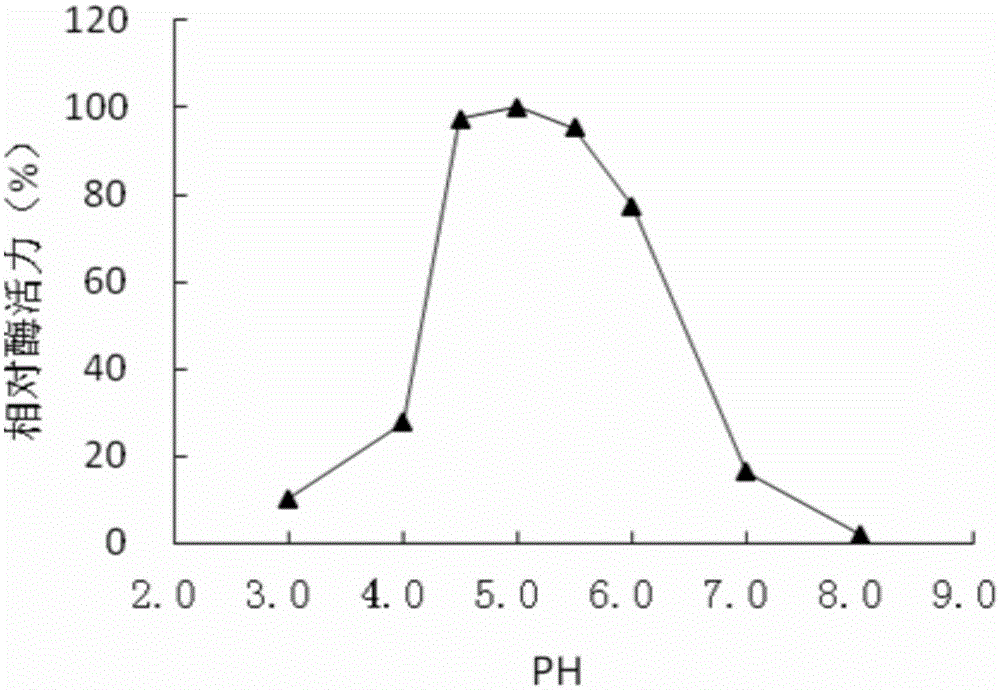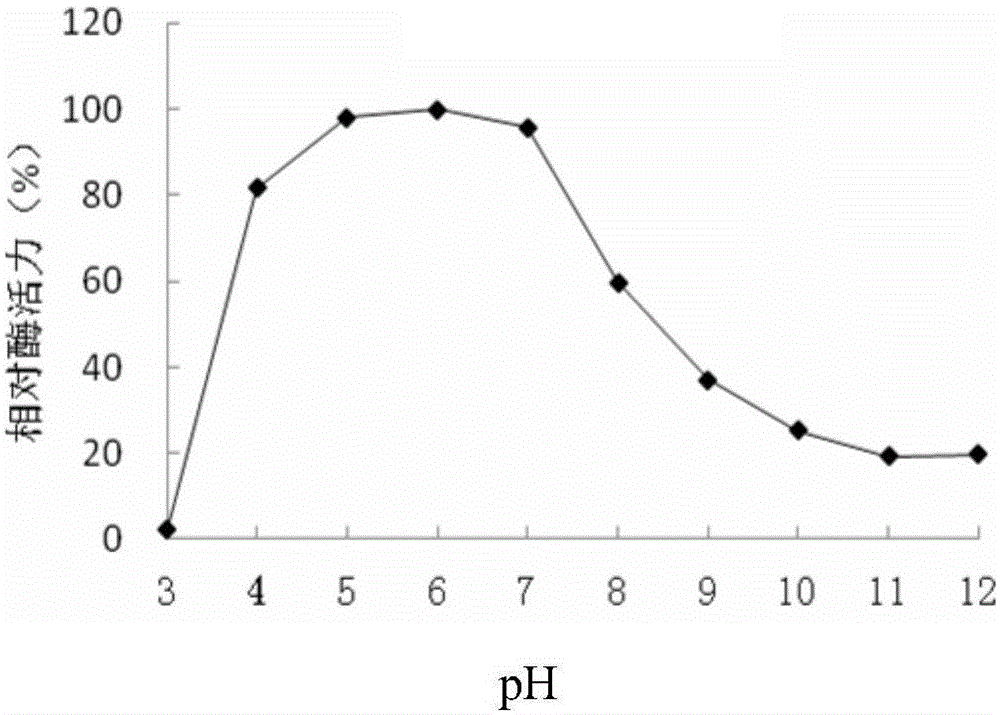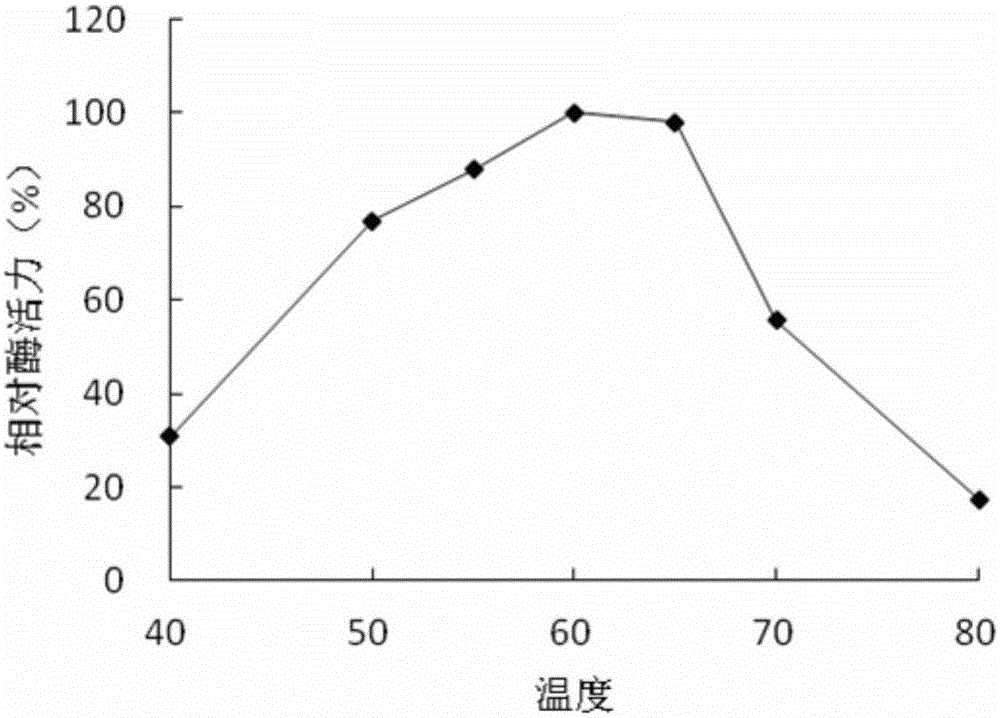Acidic cellulose from fungus and gene and application thereof
A cellulase and gene technology, applied in the field of genetic engineering, can solve problems such as low expression, inappropriate pH range, poor thermal stability, etc.
- Summary
- Abstract
- Description
- Claims
- Application Information
AI Technical Summary
Problems solved by technology
Method used
Image
Examples
Embodiment 1
[0053] Cloning of embodiment 1 cellulase coding gene cel5
[0054] Extraction of Prostheciumopalus Genomic DNA
[0055] The bacteria cultured in liquid for 3 days were centrifuged at 12,000rpm for 10min, and the collected mycelium was added to a high-temperature sterilized mortar, and quickly ground to powder with liquid nitrogen, and then the ground bacteria were transferred to a new, packed Put 15ml of CTAB lysate in a 50mL centrifuge tube, gently mix it up and down, place it in a water bath at 65°C for 3 hours, and mix it upside down gently every 20 minutes to fully lyse the bacteria. Centrifuge at 12,000 rpm at 4°C for 10 min, pipette the supernatant into a new centrifuge tube, add an equal volume of chloroform for extraction, and place at room temperature for 5 min. Centrifuge at 12,000 rpm for 10 min at 4°C. Take the supernatant and add an equal volume of phenol / chloroform for extraction, and place it at room temperature for 5 minutes. Centrifuge at 12,000 rpm for 10 ...
Embodiment 2
[0060] The acquisition of embodiment 2 cellulase cDNA
[0061] Extract Prostheciumopalus total RNA using Oligo(dT) 20 and reverse transcriptase to obtain a strand of cDNA, then design primers F and R (see Table 1) for amplifying the open reading frame, amplify the single-stranded cDNA, obtain the cDNA sequence of cellulase, and amplify to obtain product recovery Sent to Ruibo Biotechnology Co., Ltd. for sequencing.
[0062] After comparing the genome sequence and cDNA sequence of cellulase, it was found that the gene contained an intron, the cDNA was 993 bp long, encoded 330 amino acids and a stop codon, and the N-terminal 19 amino acids were its signal peptide sequence. The comparison proves that the cellulase-encoding gene isolated and cloned from Prosthecium opalus is a new gene.
Embodiment 3
[0063] The construction of embodiment 3 cellulase engineering strains
[0064] (1) Construction of expression vector and expression in yeast
[0065] Using the correctly sequenced cellulase Cel5 cDNA as a template, primers F and R (see Table 1) with EcoRI and NotI restriction sites were designed and synthesized to amplify the coding region of the mature protein of Cel5. And use EcoRI and NotI to digest the PCR product, connect it into the expression vector pPIC9 (Invitrogen, SanDiego), the sequence of the cellulase Cel5 mature protein is inserted into the downstream of the signal peptide sequence of the above expression vector, and form a correct reading frame with the signal peptide, The yeast expression vector pPIC9-cel5 was constructed and transformed into Escherichia coli competent cell Trans1. The positive transformants were subjected to DNA sequencing, and the transformants with the correct sequence were used for large-scale preparation of recombinant plasmids. Lineari...
PUM
| Property | Measurement | Unit |
|---|---|---|
| molecular weight | aaaaa | aaaaa |
Abstract
Description
Claims
Application Information
 Login to View More
Login to View More - R&D
- Intellectual Property
- Life Sciences
- Materials
- Tech Scout
- Unparalleled Data Quality
- Higher Quality Content
- 60% Fewer Hallucinations
Browse by: Latest US Patents, China's latest patents, Technical Efficacy Thesaurus, Application Domain, Technology Topic, Popular Technical Reports.
© 2025 PatSnap. All rights reserved.Legal|Privacy policy|Modern Slavery Act Transparency Statement|Sitemap|About US| Contact US: help@patsnap.com



